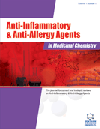- Home
- A-Z Publications
- Anti-Inflammatory & Anti-Allergy Agents in Medicinal Chemistry (Formerly Current Medicinal Chemistry - Anti-Inflammatory and Anti-Allergy Agents)
- Previous Issues
- Volume 12, Issue 3, 2013
Anti-Inflammatory & Anti-Allergy Agents in Medicinal Chemistry (Formerly Current Medicinal Chemistry - Anti-Inflammatory and Anti-Allergy Agents) - Volume 12, Issue 3, 2013
Volume 12, Issue 3, 2013
-
-
Inflammatory Cellular Phenotypes and Molecular Mechanisms of Glucocorticoid Resistance in Patients with Bronchial Asthma
More LessAsthma shows heterogeneity in the cellular sources of inflammation and response to therapy. Although glucocorticoids (GC) are very effective for the treatment of most patients with asthma, an important subgroup of patients fails to show clinical improvement. GC resistance (GC-R) could result from either inherited or acquired variation in GC sensitivity. Diverse cells, such as T helper (Th)1 cells, Th2 cells, and Th17 cells, an Read More
-
-
-
T Cell Targeted Strategies for Improved Efficacy and Safety of Specific Immunotherapy for Allergic Disease
More LessAuthors: Jennifer M. Rolland, Sara Prickett, Leanne M. Gardner and Robyn E. O'HehirAllergic diseases including asthma, rhinitis and eczema are known to be a major health and economic burden worldwide. Specific immunotherapy (SIT) is potentially curative but restricted in use, e.g. for asthmatics, due to risk of serious adverse events. Safer, effective SIT preparations require elucidation of mechanisms and immunoregulatory factors. Allergen-specific T cells play a pivotal role. For allergic individuals, allergen-sti Read More
-
-
-
N-acetylcysteine Versus Placebo for Treating Nail Biting, a Double Blind Randomized Placebo Controlled Clinical Trial
More LessAuthors: Ahmad Ghanizadeh, Nima Derakhshan and Michael BerkNail biting is a common behavioral problem. While there are established behavioral interventions for management, they are of modest efficacy, and there is minimal evidence for effective pharmacotherapy. This study investigated the role of N-acetylcysteine (NAC) a potent glutathione and glutamate modulator for the treatment of pathological nail biting in children and adolescents. This pilot randomized, double-blind, place Read More
-
-
-
Measurement of Antioxidant Activity and Antioxidant Compounds under Versatile Extraction Conditions: II. The Immuno-Biochemical Antioxidant Properties of Black Sour Cherry (Prunus cerasus) Extracts
More LessAuthors: John J. Haddad, Rana M. Ghadieh, Hiba A. Hasan, Yasmine K. Nakhal and Lama B. HanbaliRetrospectively, we have measured the antioxidant activity and a variety of antioxidant compounds under versatile extraction conditions of sweet cherry (Prunus avium) extracts. Further in this study, in order to understand the biochemical constituents and antioxidant activities of a variety of extracts of black sour cherries (P. cerasus), a related species, antioxidant compounds, including L-ascorbic acid (vitamin C), phenols, flav Read More
-
-
-
Development and Evaluation of Transdermal Organogels Containing Nicorandil
More LessAuthors: J.R. Madan, Banode Sagar, Dinesh K. Chellappan and Kamal DuaThe objective of the study was to formulate a transdermal product containing Nicorandil as a model drug, because it has been first drug of choice to treat angina and hypertension. A further objective was to reduce its side effects. The transdermal product was prepared using various synthetic and natural gelling agents such as Carbopol 934p, Carbopol 974p, HPMC K15M and HPMC K100M. Various penetration enhancers were i Read More
-
-
-
Development and Anti-microbial Potential of Topical Formulations Containing Cocos nucifera Linn.
More LessAuthors: Ravi Sheshala, Ling Teck Ying, Ling Shiau Hui, Ankur Barua and Kamal DuaIn order to achieve better treatment for local wounds and bacterial infections, topical formulations containing Cocos nucifera Linn. were developed. These formulations were evaluated for their physicochemical properties and antimicrobial efficacy against various strains of microorganisms. Semisolid formulations containing 5% w/w of Cocos nucifera Linn. were prepared by employing different dermatological bases and were Read More
-
-
-
Protein Kinase C Modulates Aurora-kinase Inhibition Induced by CCT129202 in HMC-1560,816 Cell Line
More LessAuthors: Araceli Tobio, Amparo Alfonso, Andrea Fernandez-Araujo, Eva Alonso and Luis M. BotanaThe human mast cell line HMC-1560,816 carries activating mutations in the proto-oncogene of c-kit that cause autophosphorylation and permanent c-kit receptor activation. The compound CCT129202 is a new and selective inhibitor of Aurora kinase A and B that decreases the viability of a variety of human tumor cell lines. The effect of Aurora kinase inhibition was assessed in the HMC-1560,816 line in order to find a suitabl Read More
-
Volumes & issues
-
Volume 24 (2025)
-
Volume 23 (2024)
-
Volume 22 (2023)
-
Volume 21 (2022)
-
Volume 20 (2021)
-
Volume 19 (2020)
-
Volume 18 (2019)
-
Volume 17 (2018)
-
Volume 16 (2017)
-
Volume 15 (2016)
-
Volume 14 (2015)
-
Volume 13 (2014)
-
Volume 12 (2013)
-
Volume 11 (2012)
-
Volume 10 (2011)
-
Volume 9 (2010)
-
Volume 8 (2009)
-
Volume 7 (2008)
-
Volume 6 (2007)
-
Volume 5 (2006)
Most Read This Month
Article
content/journals/aiaamc
Journal
10
5
false
en


